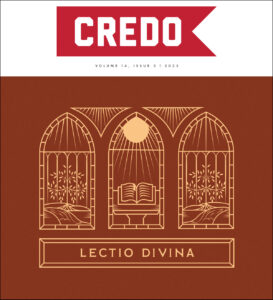In this interview, Credo’s Executive Editor Timothy Gatewood discusses Lectio Divina with Hans Boersma. Hans has served in academic ministry for over 20 years and has held positions at Trinity Western University, Regent College, and Nashotah House Theological Seminary where he currently serves as the Saint Benedict Servants of Christ Chair in Ascetical Theology. Hans’s work demonstrates a commitment to ressourcement which has led him to promote the lectio in his most recent book – Pierced By Love: Divine Reading with the Christian Tradition. In this discussion, Boersma and Gatewood address a definition of lectio divina, potential guard rails for the practice, and how the lectio interacts with hermeneutics and the doctrine of participation.
Let’s start with the basics. People react to the concept of Lectio Divina in a variety of ways. Whereas some relate the practice to spiritual formation others may relate it to a subjective and personal reading of Scripture. What is Lectio Divina, and how should we think about it?
 The term “lectio divina” literally translates as “divine reading.” Some refer to it as “meditative reading” or “contemplative reading.” Whatever term we use, it’s a reading of Scripture that keeps in mind the final aim of Bible reading—union with God, contemplation of God, deification, beatific vision. These are all words that articulate in some way the purpose for which God has made us. He wants us to be like him and with him. Scripture reading aims primarily and ultimately at this union with God.
The term “lectio divina” literally translates as “divine reading.” Some refer to it as “meditative reading” or “contemplative reading.” Whatever term we use, it’s a reading of Scripture that keeps in mind the final aim of Bible reading—union with God, contemplation of God, deification, beatific vision. These are all words that articulate in some way the purpose for which God has made us. He wants us to be like him and with him. Scripture reading aims primarily and ultimately at this union with God.
The four steps of lectio divina — reading (lectio), meditation (meditatio), prayer (oratio), and contemplation (contemplatio) — are rungs on a ladder, which aim at this ultimate goal of our true human identity in union with God.
You ask about the subjective or personal element in this. Of course, there’s a subjective or personal element in our reading of Scripture. There is in all reading, but particularly in the reading of Scripture. It would be a strange thing if our journey to eternal life with God would not be personal or subjective. Our relationship with God is deeply personal and deeply subjective. Lectio divina brings together the horizon of the biblical text with our personal horizons. Through this personal meeting with the biblical text, the Holy Spirit aims to draw us more deeply into the being or love of God.
“Theological retrieval” is a popular phrase these days, and you’ve been promoting the “rediscovery” of classical doctrines for some time now. Still, there’s much work to be done in terms of recovering classical doctrines across the board – Christology, anthropology, eschatology, and so on. In the midst of the different theological projects you could have undertaken, what compelled you to write Pierced By Love and focus your attention on Lectio Divina at this point in time?
Indeed, theological retrieval is key to the way I do theology. In fact, I would argue that all good theology proceeds by way of retrieval. Theology is tradition-bound. We read in line with previous generations. So, whenever we do our own doctrinal or theological work, we build on what they did before us, and we retrieve their theological explorations and articulations.
I like your question, because it’s fair to describe my book Pierced by Love as an effort in retrieval or ressourcement. I build on theologians from the entire tradition, East and West, while focusing especially on twelfth-century monastic theologians — the reason being that the twelfth century was a period in which lectio divina flourished perhaps like never before.
I wrote this book in part because some of my earlier work (especially Scripture as Real Presence and Sacramental Preaching) asked the question of how we should read the Bible. In those books, I have advocated for “spiritual exegesis” (to use Henri de Lubac’s famous phrase). That is to say, I make the point that exegesis is more than just pinning down the historical or literal meaning of the text, and that this holy Scripture demands holy reading: Christ is the point of all of the Scriptures. If you translate that to the theme of lectio divina, you could say: divine Scripture demands divine reading.
As you point out in your book, it’s less than appropriate to label lectio divina as a hermeneutical “method.” Indeed, you go so far as to write, “The modern preoccupation with method is alien to a sacramental exploration of the divine Scriptures.” Ultimately, you conclude that “methods” and lectio divina have different goals. How, then, would lectio divina interact with hermeneutics? For instance, can one practice both lectio divina and a historical-grammatical method of interpretation?
The four steps of lectio divina are rungs on a ladder, which aim at this ultimate goal of our true human identity in union with God. Click To Tweet Andrew Louth’s superb little book Discerning the Mystery has given me a dislike of the term “method.” He makes the point, drawing on Hans-Georg Gadamer, that “method” is a modern preoccupation. In modernity, we have increasingly modeled our Bible reading upon the empirical, scientific method of the hard sciences. The result is an approach to Bible reading that aims at the one, true meaning of the text, which is literal and historical, and which is concerned solely with authorial intent. Methods aim, in Baconian fashion, at control: we aim to master the text. Lectio divina, by contrast, longs for the text (and the God who has given us this text) to master us — to change us more fully into the likeness of God in Jesus Christ.
Lectio divina, therefore, is grounded in a hermeneutic that is at odds with the modern preoccupation with method. Now, that’s not to say that modern methods don’t yield useful results. Both historical-grammatical and historical-critical methods yield helpful data (though the former more so, I think, than the latter). But it’s crucial to keep some caveats into account. Historiography never gives us facts: it only ever gives approximations — though we can be more confident about some historical reconstructions than about others. The three or four quests for the historical Jesus are problematic because they ask us to ground our faith in a historical reconstruction rather than in the Christ of Sacred Tradition. These scholars describe themselves as historians rather than as theologians, and they want you to trust their historical reconstruction and to give your ultimate allegiance to that reconstruction — a foolish thing to do.
What is more, although the letter of the text — and its literal meaning — matters greatly, we need to keep in mind that reading (lectio) is only the first of four steps in reading Holy Scripture. The grammatical-historical method ends at the point where, for most of the tradition, the most interesting stuff is about to start. Following lectio, we have meditatio, which gives us the Christological truth or reality of the text. Here we dig for Christ, who is the treasure hidden within the Scriptures. That, traditionally, is what allegory is all about — looking for Christ as he is hidden in Scripture. Next, in prayer (oratio), the Spirit uses the text to confront us with our lives, and so we come to the moral or tropological level of meaning. The final rung of the ladder brings us the sweetness of communion with God, where in contemplatio we experience something of the divinizing union with God that will be ours forever in the hereafter. In other words, here God takes us up (anagogy), so that the eschaton cascades, as it were, into our lives.
Note that lectio divina has no fewer than three spiritual meanings (allegorical, tropological, and anagogical), which correspond to the top three rungs of divine reading (meditation, prayer, and contemplation). For those of your readers interested in pursuing this further, I would recommend they pick up Guigo II’s book The Ladder of Monks, which I think is a little gem.
When describing your new book, you write, “This book will hopefully be a helpful antidote to seeing lectio as an excuse to leave behind our critical faculties and embark on a sentimental psychologizing of the gospel, for this is not at all what earlier generations of spiritual writers had in mind.” With that claim in mind, how do we protect ourselves from fanciful or esoteric interpretations of a biblical passage while practicing lectio divina? Are there any “guard rails”?
This is a really important question. Too often, lectio divina is treated as a purely subjective thing, where you can use the biblical text as an excuse simply to import your own personal feelings and emotions, regardless of what the text actually says. In other words, we dwell upon our personal experiences while violating the text.
Holy Scripture demands holy reading. Divine Scripture demands divine reading. Click To Tweet This is a huge temptation, which plays out at several levels. For some, lectio divina becomes a way of giving ultimate authority to their personal feelings. Instead of allowing God to put our lives into question, we end up using Scripture to validate our unquestionable experiences and to dwell upon them in an inordinate fashion. We forget that through meditation and prayer, God wants to change or transfigure us. Our emotions are, therefore, not ultimate.
A similar thing happens, especially through the influence of critical theory within our postmodern Western world, when we take our identity politics into our personal reading of Scripture: we read primarily as being black, or poor, or gay. Here too, we force the Scriptures to conform to our own, pre-given and sacrosanct identities. It’s this identity that ends up functioning as the authoritative guardrail for our Bible reading.
Traditional lectio divina would have taken a rather different approach, for here it was Christ himself, the creeds of the church, the patristic consensus — in short, the Tradition of the Christian faith — that set the agenda for meditation and prayer. Here, Christ was the starting point for our reading of the Divine Scriptures. It is this Christological starting point that provided the reader with his own identity, and it is this Christological starting point that served as the guardrail and guide for a proper spiritual reading of the biblical text.
You’ve written extensively about the doctrine of participation and a participatory worldview. For instance, I think of your work Heavenly Participation in particular. Perhaps you could briefly explain this concept and tell our readers how lectio divina relates to the participatory, or sacramental, framework that you’ve promoted.
I see a participatory outlook as the metaphysical scaffolding that supports lectio divina (and spiritual exegesis more broadly). In a participatory ontology, created things are viewed as outward sacraments (sacramenta) that make present the inward reality (res) of divine things. Created things are never just what you get with the senses. They are always more than just their DNA. The reason is that creation is sacramental in character: God makes himself really present in created things. This real presence of God means, therefore, that earthly things participate in heavenly things — hence the title of my book Heavenly Participation.
The meaning of the Scriptures, too, is more than just what you get with the senses. You don’t get the fulness of the meaning of Scripture by analyzing its DNA (which is to say, by historical analysis). We get more of the light of Scripture when we ourselves receive more light. The pure in heart shall see God, Jesus tells us (Matt. 5:8). It is purity or holiness that allows us to see the hidden depths of the Scripture more clearly. The more we are transfigured and the closer we are to God (the ultimate author of Scripture), the more we grasp in our bones what the greatest depth of Scripture aims to convey to us. Spiritual things are spiritually discerned, after all (1 Cor. 2:14).
Your new book is, of course, not a how-to guide, but if someone wanted to begin practicing lectio divina, how would you suggest they start?
First, we should keep in mind that Christians often already use lectio divina even when they don’t do so deliberately. Most of us intuitively recognize that the Scriptures are God’s means of grace through which he intends to bring us closer to himself. And we often, unconsciously perhaps, read Scripture in the light of that conviction.
Second, if you want to go about lectio divina in a more deliberate fashion, I would recommend that you read Guigo II’s The Ladder of Monks, which I mentioned earlier. And you may also want to read the Introduction to my book, where I briefly discuss the various steps of lectio divina and offer some practical guidelines.
Here are some things to keep in mind: (1) Find a quiet place and begin with a period of silence. (2) Read the passage repeatedly, interspersed with silence. (3) Mediate on a word or phrase by asking how it functions in its context and within Scripture as a whole. Look for the treasure (Christ). And ask what your life (or other, broader circumstances) have to do with this. (4) Be prayerfully open to God challenging you and to repenting of sins and shortcomings. (5) Conclude with silence, as God continues his transfiguring work and as you rest in his presence.
Towards the end of Pierced By Love, you include “eight theses on lectio divina.” One thesis reads, “sermon preparation is an extended type of lectio divina.” Our readers come from a variety of backgrounds, but many of them are pastors and theologians. Why should these pastors incorporate lectio divina into their sermon prep, or, perhaps more to your point, what are they currently doing in sermon prep that may lend itself to lectio divina?
One reason I love preaching is that it forces me to sit down and do what I tell others to do in terms of lectio divina. Preaching is, to use the Dominican motto, sharing with others the fruits of your own contemplation (aliis contemplata tradere). Preaching is not sharing your historical research with the congregation. Preaching is not explaining the meaning of the text by going through it word-by-word, verse-by-verse. Preaching also is not sharing points of application that arise from the one true meaning of the text. Preaching is a proclamation of Christ after you have been in his presence.
Most of us preachers know this. Through the week, God has confronted us with the text. He has spoken to us, convicted us, changed us. In other words, we have read, meditated, prayed, and even, to some extent, contemplated. As we turn to God’s people, we share some of this experience with God’s people, so that they too may receive Christ more deeply and may be transfigured by the light of his countenance.
Finally, if you could instantly erase one popular misconception concerning lectio divina with the snap of your fingers, what would it be?
The misconception would be this: lectio divina is a form of self-indulgence, which enables people to wallow in their subjective feelings. No! The opposite is the case: lectio divina often painfully pierces our soul, in the process of taking us into the presence of God. Lectio divina is an ascetic discipline, which invariably requires hard work and self-denial.



